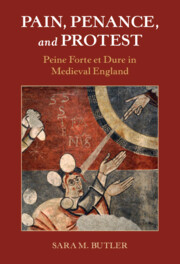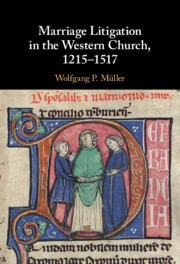Refine search
Actions for selected content:
27 results
5 - De-Confusing Confession at Finnegans Wake
-
-
- Book:
- The Cambridge Companion to James Joyce
- Published online:
- 14 August 2025
- Print publication:
- 21 August 2025, pp 84-101
-
- Chapter
- Export citation
16 - Tertullian of Carthage, On Repentance and On Modesty 1–4, 21–22
- from Part III - Imagining the Community
-
-
- Book:
- The Cambridge Edition of Early Christian Writings
- Published online:
- 19 May 2025
- Print publication:
- 12 June 2025, pp 293-321
-
- Chapter
- Export citation
14 - Canon Law in the Early Middle Ages
- from Part III - Canon Law
-
-
- Book:
- The Cambridge History of the Papacy
- Published online:
- 28 February 2025
- Print publication:
- 20 March 2025, pp 368-384
-
- Chapter
- Export citation
Chapter 2 - Repentance
-
- Book:
- Protestant Bodies
- Published online:
- 20 February 2025
- Print publication:
- 27 February 2025, pp 83-117
-
- Chapter
- Export citation
7 - The Frankish Churches
-
- Book:
- Merovingian Worlds
- Published online:
- 22 November 2024
- Print publication:
- 05 December 2024, pp 208-237
-
- Chapter
- Export citation
Chapter 1 - Counterfeit Money
-
- Book:
- The Theology of Debt in Late Medieval English Literature
- Published online:
- 04 January 2024
- Print publication:
- 18 January 2024, pp 25-49
-
- Chapter
- Export citation
Repentance, Atonement, and Aquinas
-
- Journal:
- New Blackfriars / Volume 105 / Issue 1 / January 2024
- Published online by Cambridge University Press:
- 26 January 2024, pp. 61-76
- Print publication:
- January 2024
-
- Article
- Export citation
Chapter 3 - (Not) of This World
-
- Book:
- The Early Christians
- Published online:
- 05 October 2023
- Print publication:
- 26 October 2023, pp 223-304
-
- Chapter
- Export citation
Army style, we marched: War and peace in the cross-carrying pilgrimages to Vézelay and Walsingham, 1946-1948
-
- Journal:
- British Catholic History / Volume 36 / Issue 4 / October 2023
- Published online by Cambridge University Press:
- 30 November 2023, pp. 410-430
- Print publication:
- October 2023
-
- Article
-
- You have access
- Open access
- HTML
- Export citation
7 - The Sacrament of Penance at the Council
-
-
- Book:
- The Cambridge Companion to the Council of Trent
- Published online:
- 02 October 2023
- Print publication:
- 16 March 2023, pp 139-155
-
- Chapter
- Export citation
Chapter 9 - Askesis and Asceticism
- from Part I - Shakespeare and Virtue Ethics
-
-
- Book:
- Shakespeare and Virtue
- Published online:
- 19 January 2023
- Print publication:
- 26 January 2023, pp 88-97
-
- Chapter
- Export citation
The War Is Over but the Moral Pain Continues
-
- Journal:
- Ethics & International Affairs / Volume 36 / Issue 1 / Spring 2022
- Published online by Cambridge University Press:
- 10 March 2022, pp. 7-13
-
- Article
- Export citation

Pain, Penance, and Protest
- Peine Forte et Dure in Medieval England
-
- Published online:
- 19 November 2021
- Print publication:
- 18 November 2021
4 - Peine Forte et Dure as Barbarity? Putting the Practice in Context
-
- Book:
- Pain, Penance, and Protest
- Published online:
- 19 November 2021
- Print publication:
- 18 November 2021, pp 188-249
-
- Chapter
- Export citation
1 - Peine Forte et Dure: The Medieval Practice
-
- Book:
- Pain, Penance, and Protest
- Published online:
- 19 November 2021
- Print publication:
- 18 November 2021, pp 26-79
-
- Chapter
- Export citation

Marriage Litigation in the Western Church, 1215–1517
-
- Published online:
- 03 September 2021
- Print publication:
- 16 September 2021
‘Saving Our Order’: Becket and the Law
-
- Journal:
- Ecclesiastical Law Journal / Volume 23 / Issue 2 / May 2021
- Published online by Cambridge University Press:
- 27 April 2021, pp. 127-139
- Print publication:
- May 2021
-
- Article
- Export citation
Chapter 9 - The Theology of the Afterlife in the Early Middle Ages, c. 400–c. 1100
- from Part II - Theological Perspectives
-
-
- Book:
- Imagining the Medieval Afterlife
- Published online:
- 07 December 2020
- Print publication:
- 17 December 2020, pp 153-175
-
- Chapter
- Export citation
Chapter 6 - Otherworld Journeys of the Central Middle Ages
- from Part I - Chronological Surveys
-
-
- Book:
- Imagining the Medieval Afterlife
- Published online:
- 07 December 2020
- Print publication:
- 17 December 2020, pp 99-114
-
- Chapter
- Export citation
11 - Shakespeare’s King Lear and the Bible
-
-
- Book:
- The Cambridge Companion to the Bible and Literature
- Published online:
- 13 March 2020
- Print publication:
- 26 March 2020, pp 181-199
-
- Chapter
- Export citation
